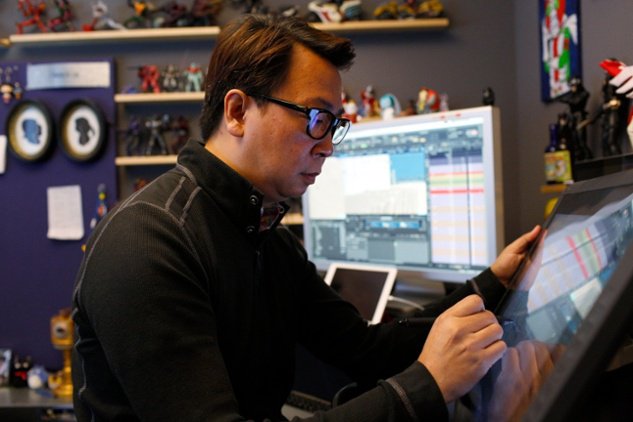How this CCA film major landed his Pixar dream job
CCA alumnus Patrick Lin never thought he would have a career in animation.

Photo of Patrick Lin taken by Deborah Coleman, photo editor for Pixar. ©2015. Disney•Pixar. All Rights Reserved.
Growing up in Hong Kong, he was inspired by Hollywood titans George Lucas and Steven Spielberg, and decided he would someday make films. This dream led him to the CCA film program, where, unbeknownst to him, he began laying the groundwork for one of the most coveted Pixar jobs: Director of Photography.
While Lin may not have had an animator’s background, the art of camera and staging, a.k.a. layout, prepared him for success. Among many other things, layout directs the viewer’s eye and enhances their emotional experience of a film, whether live-action or animated.² Lin’s talent for merging the tools of cinematography with the digital intricacies of 3D animation has helped Pixar, his longtime employer, reinvent camera language.
A cinematographer's path to Pixar
From live-action lighting to leading layout on award-winning animation features, Patrick Lin’s career trajectory is a remarkable example for students considering a top animation program. Here’s a snapshot of his 20+ years in the entertainment industry:
- Attends CCA for film and is captivated by the rich visual language of live-action filmmaking
- Stays in the Bay Area to build his CV and take advantage of the many local production houses
- Lands his first big industry gig as a camera and lighting assistant on James and the Giant Peach
- Works as a motion control photographer on X-Men, Wag the Dog, and The Truman Show
- Becomes a director of photography (with Midland Productions) for IMAX, SeaWorld, and Tower Records
- Starts his first Pixar job as a layout artist on A Bug’s Life
- Continues with the Camera and Staging Department on 11 more Pixar features
- Supervises a team of Pixar layout artists on The Incredibles, Up, The Blue Umbrella, and Inside Out as Director of Photography
What’s Lin up to now? Toy Story 4.
When live-action meets 3D animation
Toy Story (1995) was the first feature-length film to be made entirely with computer animation. It broke all the rules by reimagining modeling environments with animation software. Furthermore, the film set the stage for sophisticated computer-animated people, which was tremendously difficult in the mid-90s. When Lin first saw Toy Story, he also saw the potential for layout and lighting techniques that would complement this new kind of storytelling.
Students in animation programs know all too well that “Lights, camera, action!” is a myth. For an animator, all these elements happen separately. Layout is at the front of the production line, literally setting the stage for animation, set/prop design, and lighting.
"Just Like Joy," movie clip from Inside Out, 2015. Disney•Pixar.
The new order: camera, action, lights.
Like a cinematographer on a live-action set, Lin defines what a Pixar film will look like by selecting points of view, ranges of sight, and where to place the camera for the best perspective. Students in the CCA animation program go through a similar process when they block characters and story beats, establish choreography for characters and objects, and frame the shots to inform timing and camera movement.
Calling on artists to reinvent the playbook
One thing we know for sure—thanks to our many Pixar-CCA connections—is that Pixar values applicants with a strong foundation in traditional art more than those with specific animation software skills. Pixar uses its own in-house proprietary software for scene layout, rigging, simulating physics, and more, so those who make the cut will have to learn a whole new system anyway!
“Every story envisioned by the Pixar team requires something that they don’t know how to do, so they invent the technology that was needed.” —TIME
How Inside Out changed the game
What Pixar can’t create digitally, however, is imagination, instinctual gesture (drawing), and an artist’s unique ability to challenge the status quo and construct new methods for process and performance. Take Inside Out, for example. Patrick Lin applied his experience as a live-action cinematographer to push the studio in two new, history-making directions:
- The first virtual lens to be modeled on a real-world camera lens. Mathematically true to a real camera, Pixar’s virtual lens has the ability to move on a track, dolly, or even appear to be hand-held. Lin and his team did this to help viewers distinguish between the interior and exterior worlds of the film.⁸
- The first motion-capture camera locked to a virtual set. A career in animation is a steadfast dedication to invention. To capture every nuanced motion, Lin and his team of layout artists used a special camera that can see and analyze all the digital assets of an animated film, making it possible to capture the virtual world with real-world motion, however raw and imperfect, for the first time.⁹
Careers at Pixar are truly made when creative thinkers turn problems into opportunities. The ability to subvert, critique, and reimagine existing paradigms is crucial for any animator. The trick is finding a program that will challenge you, through experimentation, collaboration, and purposeful critique, to create a stand-out demo reel. That's why students apply to California College of the Arts for Animation, where many professors are also celebrated Pixar animators.